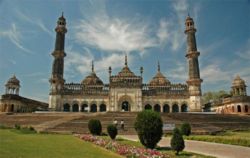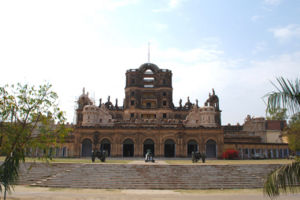Lucknow
| Lucknow | |
|---|---|

| |
| Presidency: Bengal | |
| Coordinates: | 26.812800°N, 80.901300°E |
| Altitude: | 123 m (404 ft) |
| Present Day Details | |
| Place Name: | Lucknow |
| State/Province: | Uttar Pradesh |
| Country: | India |
| Transport links | |
| ‘Oudh and Rohilkhand Railway ’(O&RR) ‘Great Indian Peninsula Rly’(GIPR ‘Rohilkund and Kumaon Railway’ (R&KR) ‘B&NWR Cawnpore-Burhwal Railway’ See page Lucknow Railways and Stations for details | |
| FibiWiki Maps | |
|---|---|
| See our interactive map of this location showing places of interest during the British period | |
| Lucknow |
Lucknow, a city in north-central India 500 km southwest of Delhi, was the headquarters of Lucknow District in the Lucknow Division of United Provinces during the British period.
It was the scene of a major siege during the Indian Mutiny, when the Residency was defended against great odds by a small group of soldiers and civilians, including schoolboys from La Martiniere College.
Spelling variants
Modern name: Lucknow
Variants: Lukhnow/Luknow/Lakhnao/Lakhnau/Nucklao
Military history
For details of events during the Indian Mutiny see main article Events at Lucknow
Volunteer Regiments
"Lucknow is the head-quarters of the Oudh and Rohilkhand Railway Volunteer Rifles, the Lucknow Volunteer Rifles and the Oudh squadron of Light Horse"[1]
Maps
FIBIS database
Transport
Lucknow became an important railway hub for both broad and metre gauge lines, headquarters of the Oudh and Rohilkhand Railway (which also had two major workshops situated close by, at Alambagh and Charbagh), and a terminus for the Rohilkund and Kumaon Railway's line from Bareilly.
Churches
Anglican:
- All Saints Garrison Church - (see External links section below for photos).
- Christ Church Cathedral
- St Mary's at the Residency - Photos of the cemetery on the FIBIS database
- St. Peter's the Railwaymen's Church, Charbagh, Lucknow. Built as the railwaymen's church of the Protestant Anglican communities of Charbagh and Alambagh in Lucknow, and opened in 1915. Prior to that, the congregation assembled somewhere in the present day Loco Workshop. [2]
Roman Catholic
- St Joseph's Cathedral
Church of Scotland
- Saint Mungo's Church of Scotland, Lucknow Cantonment December 25, 2019. "Colonial Lucknow"
Memorials
Memorials of Colonial Lucknow photographs by Vineet Wal on flickr.com
FIBIS database
- Thomas Henry Kavanagh was a civilian who won the Victoria Cross for his action during the Siege. One of those inside the Residency, he disguised himself as a sepoy in order to escape undetected to the Alambagh and guide Campbell's forces into Lucknow for the Second Relief. Kavanagh's memorial in the All Saints Garrison Church can be view on the FIBIS database.
Cemeteries
- FIBIS database: Lucknow Cemeteries
- "Cemetery at Vilayati Bagh in Lucknow" September 20, 2013. "Colonial Lucknow".
Education

See also Schools
- Canning College - founded 1864
- Colvin Taluqdars' College - a Public School, established 1889
- Jubilee High School
- Loreto Convent - Catholic school, founded 1872
- La Martiniere College - boys school established 1845, girls schools established 1869. Photos on the FIBIS database.
- Reid Christian College
- St. Francis' School and Orphanage - Catholic school, founded 1885
FIBIS resources
As well as those resources already included in appropriate sections, the following can be found on the FIBIS database:
- Photographs of Lucknow by C Jackson, a painter and gilder for the Maharaja of Balrampur.
- Letter from Lieutenant Clifford Mecham sent during the Defence of Lucknow 1857
- Miscellaneous Lucknow photographs
Further Fibiwiki images may be browsed at Lucknow images
Recommended reading
- Lucknow – Families of the Raj by Malcolm Spiers, published 2013.
- A review by Richard Morgan is contained in FIBIS Journal Number 30 (Autumn 2013) page 45
External links
- Lucknow Imperial Gazetteer of India
- Siege of Lucknow Wikipedia
- Lucknow Wikipedia
- La Martiniere College, Lucknow Wikipedia
- Photos of All Saints Garrison Church 9 July 2012 from "Beautiful Indian Churches". Earlier 2011 photos from the same website here and here
- Holy Redeemer Church (Roman Catholic), Lucknow April 4, 2015. "Colonial Lucknow".
- History’s Ghosts in Old Lucknow Story and photos by Margaret Deefholts www.margaretdeefholts.com
- "Childhood Memories of India" by John Goddard, KRRC . KRRC Association. The author was born in 1923 and lived most of the time until 1933 in India, in cantonments in Lucknow and Calcutta. His father was officers’ mess sergeant in a battalion of the King’s Royal Rifle Corps (the 60th Rifles)
- Cliff's Calcutta: How Richard's singing career actually began in the British Raj by Steve Turner 13 January 2013 dailymail.co.uk. The singer Cliff Richard was born in Lucknow in 1940. His mother had travelled from her home in Dehra Dun, because Lucknow had a reputable hospital, ‘a popular hospital – very British as well’.This may have been the Lady Dufferin Hospital, then renowned for its modern maternity unit.
Historical books online
- "Lucknow City" Imperial Gazetteer of India, Volume 16, page 188.
- Lucknow : a Gazetteer ; Volume 37 District Gazetteers of the United Provinces of Agra and Oudh by H R Nevill 1904 Deutsche Digitale Bibliothek. Also available Archive.org
- District Gazetteers of the United Provinces of Agra and Oudh: Volume 37: Lucknow Division 1916 may be downloaded as a pdf from Bhagirathi - The Institute Repository of IIT Roorkee. This volume is probably Supplementary Notes and Statistics.
- The Lucknow Album : containing a series of fifty photographic views of Lucknow and its environs together with a large sized plan of the city 1874 Archive.org
- The Tourist's Guide to Lucknow by Edward H Hilton 1894. Archive.org. Also includes background information about the Siege of Lucknow 1857.
- The Guide to Lucknow with Historical Notes on Mutiny of 1857 by M A Beg. Reprint of 6th edition 1911. Archive.org, Historical Resources of India Collection.
- Lucknow (the capital of Oudh): an illustrated guide to places of interest, with history and map by Lieut.-Colonel H A Newell Fourth Edition c 1920s? (One earlier edition was published in 1916) Archive.org
- Historic Lucknow by Sidney Hay, Illustrated by Enver Ahmed. 1994 reprint edition, first published 1939. Archive.org.
- "Lucknow" digital page 1050 (page 53 of the Provincial Section/United Provinces section) Thacker's Indian Directory Including Burma 1940-41 Archive.org
- Observations on the Mussulmauns of India : descriptive of their manners, customs, habits and religious opinion made during a twelve years' residence in the immediate society by Mrs. Meer Hassan Ali. Edited with notes and an introduction by W. Crooke 1917. The authors background is unclear, other than that she was an English lady of high social rank, who married in England c 1816, and lived most of the time in Lucknow, see the Introduction. Page ix. Originally published 1832. Volume I, Volume II. Archive.org.
- Lucknow page 368 Report of the Commissioners Appointed to Inquire into the Sanitary State of the Army in India : with Abstract of Evidence, and of Reports Received from Indian Military Stations 1864 Archive.org
- My Garden in the City of Gardens: A Memory by Edith E Cuthell 1905 Archive.org. Memories of life as an Army Officer’s wife in Lucknow.
- The Raj, the Indian Mutiny and the Kingdom of Oudh, 1801-1859 by John Pemble 1977 Archive.org Books to Borrow/Lending Library.
References
- ↑ Lucknow Imperial Gazetteer of India, Volume 16, page 197
- ↑ St. Peter's the Railwaymen's Church, Charbagh, Lucknow by Nikhil Katyal April 3, 2016. "Colonial Lucknow"